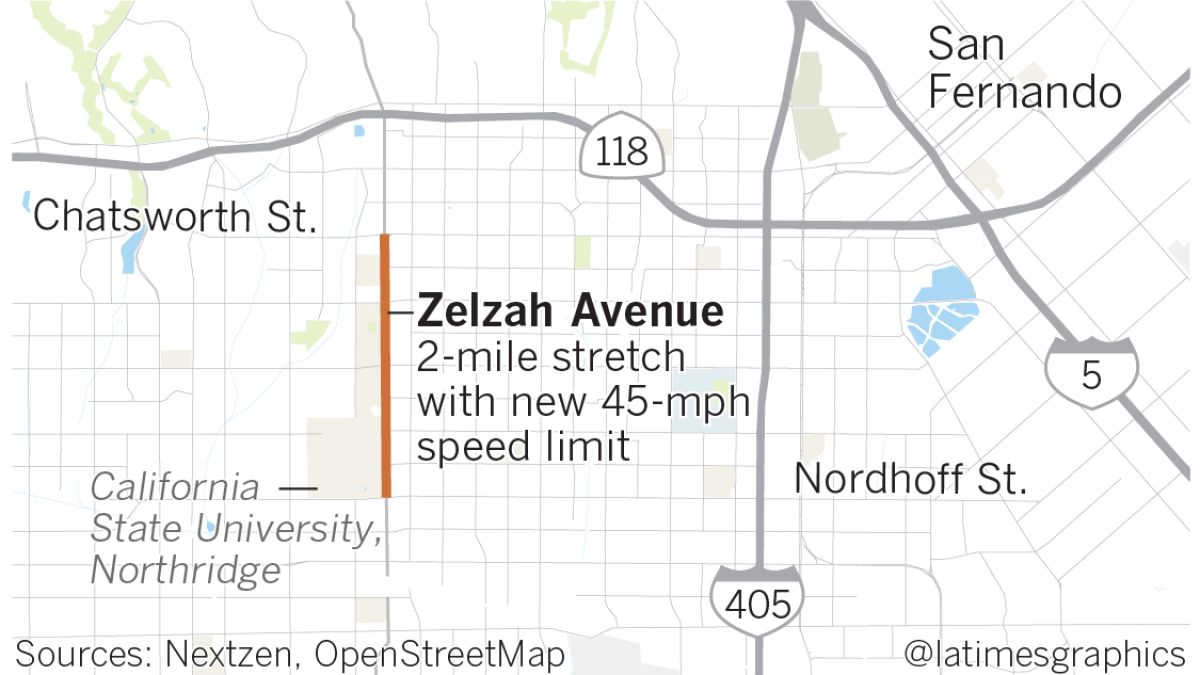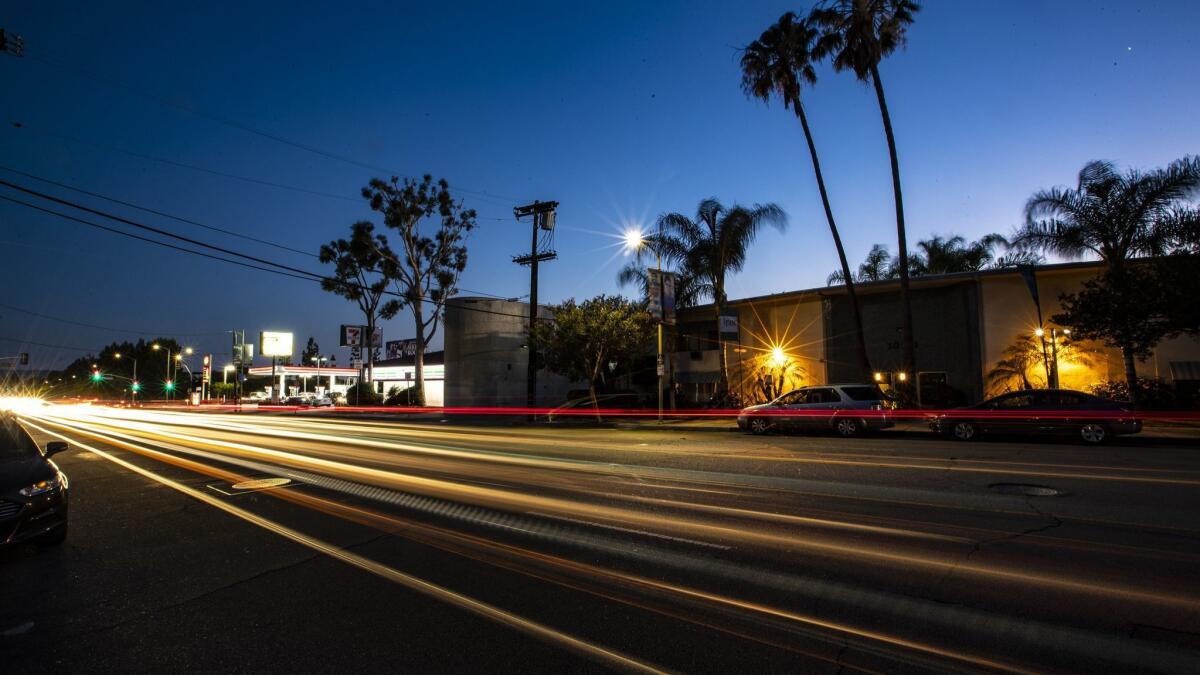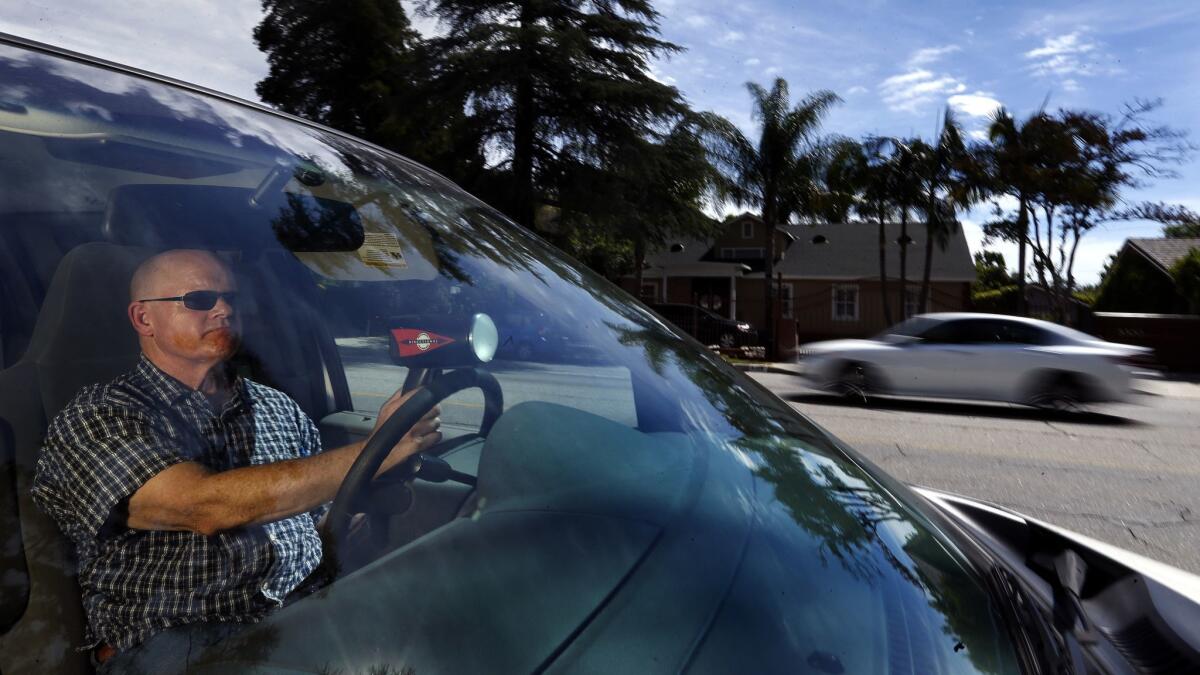As L.A. struggles to reduce traffic deaths, speed limits keep going up

Los Angeles has faced a Catch-22 for decades on miles of major streets. Either raise the speed limit or lose the most common way to ticket speeders.
Sheila Brown was shocked to learn, in the spring of 2009, that the Los Angeles City Council was planning to raise the speed limit on Zelzah Avenue, a few blocks from her home in Granada Hills.
A few weeks before, a 60-year-old woman had been struck and killed in a crosswalk on Zelzah, Brown told the City Council in an impassioned letter. She said the frequent sounds of screeching tires as drivers narrowly avoided collisions were proof that allowing higher speeds would put residents and students in danger.
“How many more people need to die in order to prove this to you?” Brown asked.
Two months later, the City Council raised the speed limit on Zelzah to 40 mph from 35. Last December, the limit went up again, to 45 mph — even though Zelzah is now classified as one of the city’s most dangerous streets for pedestrians and bicyclists.

Zelzah’s growing speed limits epitomize the catch-22 that Los Angeles officials have faced for decades on dozens of miles of major city streets: Raise the speed limit, or lose the ability to write most speeding tickets.
The dilemma stems from a decades-old California law designed to protect drivers from speed traps, which requires cities to post speed limits that reflect the natural speed of traffic. If the limit is too low, or if it is years out of date, the police can’t use radar guns or other electronic devices to write speeding tickets there.
Sharp drop in speeding tickets
More than 200 miles of Los Angeles streets have expired speed limits and very little speed enforcement. Those streets include crosstown thoroughfares and a handful of corridors that are considered the deadliest for pedestrians and bicyclists.
The restrictions on police using electronic devices has coincided with a 77% drop in the number of speeding tickets written annually by the Los Angeles Police Department, from 99,333 in 2010 to 22,783 last year.
Traffic officers have been particularly hamstrung in the San Fernando Valley, where the majority of the city’s speeding tickets are written and more than 130 miles of streets carry speed enforcement restrictions, according to a Times analysis of city data.
“People are driving like maniacs on city streets,” said Dennis Zine, a former city councilman in the Valley who worked as a traffic officer. “It’s costing people their lives.”
Los Angeles has worked frantically to update speed limits so traffic officers can resume their work, renewing the speed limits on more than 650 miles of streets in the last two years.
Transportation Department officials first studied the streets the city considers the most dangerous for bicyclists and pedestrians, such as Zelzah. As a result, officers can now write speeding tickets on more than 95% of these streets, compared with just 20% in 2016, officials said.
In December, the City Council raised speed limits on 94 miles of streets, mainly in the Valley. The city also lowered limits on 52 miles of streets where traffic has slowed over time, mostly in central and south Los Angeles.

Some streets, including Balboa and Chandler boulevards, had not seen speed enforcement for more than a decade. Drivers had grown accustomed to speeding with no citations, police said. Higher average speeds forced the city to raise the speed limit to resume ticketing.
Speeding has become a significant stumbling block for Vision Zero, Los Angeles Mayor Eric Garcetti’s directive to eliminate traffic deaths on city streets by 2025.
By one measurement, the problem is getting worse: In the first two years of Vision Zero, pedestrian deaths rose 82%. The increase suggests that pedestrians are being hit by drivers at higher speeds than in the past, officials say.
A pedestrian struck by a driver going 20 mph has a 90% chance of survival, but a 20% chance of survival at 40 mph, according to federal data. The data inspired the advocacy catchphrase “20 is plenty,” which urges a 20-mph speed limit in cities.
‘Officers don’t want to do estimations’
Police officers say it is better to have an enforceable speed limit, even if it is higher, than having none at all, because they can ticket the worst offenders.
Without radar guns or other electronic devices, police can estimate a vehicle’s speed by sight or by driving alongside it, methods that are less accurate and more likely to be thrown out in court.
“Officers don’t want to do estimations,” said LAPD Officer Troy Williams, who has worked in Valley traffic enforcement for more than a decade. “They don’t want to go to court for nothing, and get embarrassed by some judge, or an attorney who tries to act like Perry Mason.”
Instead, officers will try to cite speeders for other moving violations, including failing to signal or using a cellphone while driving, he said. Officers can also cite drivers going faster than 65 mph, even if the street does not have a current speed limit, he said.
Police can also use radar and laser devices to ticket speeders in school zones, where the limit is 25 mph when children are present, whether the street’s regular speed limit is current or not.
California transportation advocates take a dim view of the policy that pegs speed limits to how fast people generally drive. Too many people already feel comfortable driving at speeds that are fatal to pedestrians and cyclists, they say.
“You’re letting the inmates run the asylum,” said bicycle advocate Stephen Box, who fought a wave of speed limit increases across the Valley nearly a decade ago. “A city does a speed survey to enforce the speed limit — except now, people can drive faster.”
He added: “There’s no human on Earth that can look at this and say, with a straight face, ‘That makes complete sense,’ except the LAPD and the LADOT.”
California’s speed limit law was first drafted more than five decades ago, when police officers first began using radar guns to catch speeders. Fears mounted that technology would make it easier for cities to set speed limits far below the normal flow of traffic, pick drivers off one by one, and pocket the revenue.
State officials endorsed a policy requiring cities to post limits that are based on driver speeds, and that are updated regularly.
To update driver speeds, city engineers visit a street in the late morning or early afternoon, park along a stretch of road without stop signs or traffic lights, and use an electronic device to measure the speeds of 100 drivers.
They rank the speeds from fastest to slowest and identify the 85th percentile — that is, the speed just below the 15th-fastest driver. City engineers use that “critical speed” as a basis for establishing a new speed limit, typically rounded to the nearest 5 mph.
On a sunny morning last year, transportation engineer Brian Doherty sat in the curb lane on Fulton Avenue in Sherman Oaks. The street, lined with ranch houses, had a speed limit of 35 mph that expired in 2012, according to records obtained by The Times.

Doherty balanced a radar gun on the top of the steering wheel and took aim at drivers zipping toward him. With a screeching sound like a dial-up modem, the device began to display speeds for each passing vehicle: 37, 39, 44.
“Fifty-five, my,” Doherty said, as a driver in a black Scion blew past, rattling the van’s windows. He made a tally mark on his clipboard next to “55 mph.”
A later analysis found that Fulton’s critical speed was 42 mph. Engineers rounded down to 40 mph, then reduced the limit by another 5 mph, citing disconnected sidewalks, varying street widths, and “dense shrubbery restricting views of driveways.” The city set the limit at 35 mph — leaving it unchanged.
Cities can reduce a speed limit by an additional 5 mph in some circumstances, as Los Angeles did on Fulton, by citing collision records, safety issues for bicyclists and pedestrians, or “conditions not readily apparent to the driver,” including hidden driveways or a nearby park or school.
Los Angeles also used the provision on Zelzah, where engineers measured a critical speed of 48 mph. Citing 13 crashes involving pedestrians and bicyclists in three years, the city rounded the posted limit down to 45 mph, still a 5-mph increase.
L.A. fell behind during recession
To keep up with L.A.’s more than 1,200 miles of surveyed streets, transportation officials have tried to renew the studies for about 200 miles of streets per year.
But during the Great Recession, L.A.’s rate sank far below that, as the Transportation Department’s survey group lost five of its seven employees to hiring freezes, medical leave and early retirement, officials said.
“It was a dark time for the city, and there were a lot of things that ended up not getting done,” said Seleta Reynolds, the department’s general manager, who was hired in 2014. “This was one of them.”
At the same time, engineers were forced to recommend higher speed limits on dozens of miles of streets, mostly in the Valley. The increases required City Council approval, but some members saw the votes as so controversial that they let the speed limits expire without making a decision.
“It’s an autobahn,” said David Lasher, who was rear-ended on Rinaldi Street in Porter Ranch. The posted speed limit is 45 mph, he said, and many drivers go much faster.
The Transportation Department denied The Times’ request for the database of streets with current and expired speed limits, despite releasing the same record three years ago.
The risk created by making the information public as traffic deaths rise outweighs the public’s right to access government records, said department spokeswoman Patricia Restrepo, citing the balancing test outlined in the California Public Records Act.
The department does not “want to release a list of streets to the public where they can speed with impunity,” Restrepo said last year.
There’s little evidence that a higher speed limit encourages people to speed, Williams of the LAPD said. He cited a Federal Highway Administration study in 22 states that found raising or lowering the speed limit had little effect.
That conclusion remains in dispute at the federal level. Researchers with the National Transportation Safety Board recommended last year that officials move away from the 85th-percentile policy, saying it leads to “unintended consequences,” including more speeding.
“The emotional argument is that raising the speed limit to 40 mph will make people drive faster,” Williams said. “But most people don’t really know what the speed limit is when they’re driving.”
That’s true, city officials say — and instead, street designs need to change to force people to drive more slowly. The city plans to retrofit streets that are designed to move as many cars as possible by subtracting travel lanes, adding bike lanes and building medians.
People are driving like maniacs on city streets. It’s costing people their lives.
— Dennis Zine, a former city councilman in the Valley who worked as a traffic officer.
Los Angeles officials have also backed changes to the state’s 85th-percentile law, but there are few proven alternatives. Attempts at reforming the law have repeatedly failed in Sacramento.
A bill to start a test program for speed cameras, which are banned in California, died in committee last year.
A recent bill introduced by Rep. Laura Friedman (D-Glendale) would have allowed cities to set speed limits up to 9 mph below the critical speed. It was gutted after a legislative analysis found that nearly half of drivers would be eligible for a $238 speeding ticket.
A new version of the bill would study efforts to reduce traffic deaths, including other ways to set speed limits.
As legislators chew over whether to overhaul the law, Brown continues to fear that Zelzah Avenue is growing more dangerous. Her home is a few blocks north of the 45-mph zone, on a block with no sidewalks. Drivers scream past at uncomfortable speeds as Brown and her neighbors drag their recycling bins to the street.
Recently, she said, a driver in a BMW crashed into a utility pole, ricocheted off and struck the curb on the other side of the street. Then the city raised Zelzah’s speed limit again.
“How many times do you have to hear screeching tires and people running into each other before you decide this isn’t working anymore?” Brown asked.
Twitter: @laura_nelson
More to Read
Sign up for Essential California
The most important California stories and recommendations in your inbox every morning.
You may occasionally receive promotional content from the Los Angeles Times.











